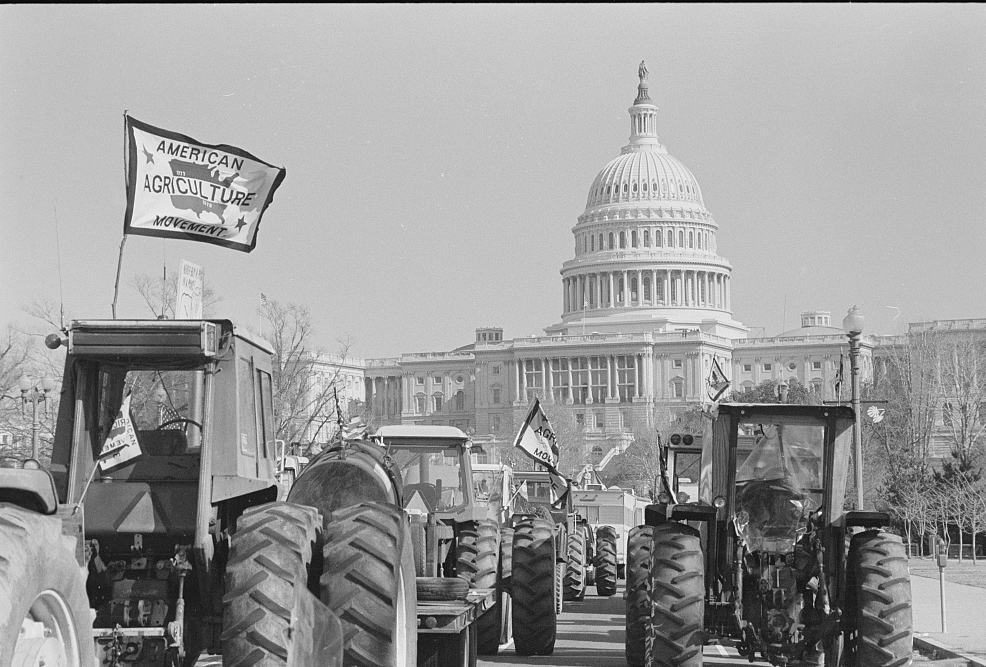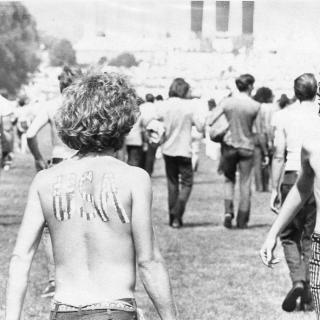Tractorcade 1979
By the end of the first week in February 1979 thousands of farmers had descended upon the National Mall to lobby Congress for a new farm bill to increase crop prices and influence in agriculture policy. They barreled into the city, at a whopping 15 miles per hour, coming from as far away as Texas, Michigan, and Colorado.[1]
Organized by the American Agriculture Movement, the protest really had no semblance of a plan. Ken Lane at the American Agriculture Movement’s DC headquarters told reporters, “They’re coming to town. That’s all we know.”[2]
President Jimmy Carter, being a farmer himself, offered a sympathetic word of support saying, “I don’t know of any other group that has suffered more from inflation than farmers.”[3]
While the President was supportive of the plight of the farmers converging on Capitol Hill, much of Congress did not feel the same way, even the farmers among them. Freshman Democrat from Texas and farmer, Charles W. Stenholm was worried about the effectiveness of a "tractorcade." “The farmers’ story is still valid. Their income levels are still not adequate, but I question the advisability of a tractorcade. I don’t feel a tractorcade will be helpful this year.”[4]
Still, on Feb. 5, thousands of tractors, campers, and trucks stampeded into Washington, tying up traffic for what would end up being weeks. The protesters vowed to maintain a continuous parade of tractors blockading Pennsylvania Avenue. Those not parading camped on the National Mall and were immediately barricaded in by police cruisers and city trucks and buses. For those weeks, the National Mall became “Tractortown.”[5]
The farmers clearly resented being rounded up and confined to the Mall. One farmer from Kansas, Larry Schmitz, told. “We’re shut up here like a bunch of animals in a corral. We come here trying to do something for this country and they treat us like this.”[6]
While D.C. Police did not want a confrontation with protesters, the city and National Park Service was eager to see them leave. Park Police spokesman George Berklacy told The Washington Post, “[w]e would be delighted if they left right away. But we have to play it by ear. There is no set date that we are going to force them off the Mall.”[7]
Despite the pressure, the farmers seemed as determined as ever. Greg Westmoreland, a farmer from West Bay, Texas, had no intention of leaving despite the police pressure. “We’re gonna [sic] be here a while. We didn’t drive no [sic] 1,900 miles to go home after a couple days.”[8]
As the protests entered their third week in D.C., the most devastating blizzard the city had seen in decades struck, and the entire area came to a complete standstill.[9]
Even though forecasters had called for only two to four inches of snow, Washington area residents woke up on President’s Day to find more than two feet of snow in some places. Interstates 95 and 495 were almost completely blocked by snow, public transit was all but shut down and all three of the area’s airports were closed. All 500 of the city’s buses were out of service (90 had already gotten stuck in the snow) and the newly minted Metrorail was shut down for days. According to reports from Dulles Airport, visibility was so bad at the airport that snowplows had crashed into each other.[10]
For some it was a snow day like any other; snowball fights, building snowmen and skiing. But for officials in D.C., the storm was a major headache. The city's snowplows were overpowered by the powder, so the farmers, who had been driving the streets surrounding the Mall began plowing and offered their services to D.C. and its suburbs. While the region was digging out, the farmers ferried doctors, nurses, and emergency vehicles to and from hospitals throughout the D.C. area.[11]
The then-newly elected Senator from Virginia, John Warner, also hitched a ride with the farmers. He made sure to get to the Capitol to deliver the annual reading of George Washington’s Farewell Address. “If George Washington could make it through Valley Forge,” he quipped, “a freshman Senator from his state could certainly tread the path from the Port of Georgetown.”[12]
The farmers' plowing endeared them to the D.C. public. As the snow melted, the tractorcade soon reverted back to its parades around the White House and Capitol Hill. While he sat in tractorcade traffic, Wilson Follin, a D.C. cab driver, told The Washington Post, “I didn’t like it so much the first day they were here, but I think they need a break.”[13]
The streets were plowed, but after three weeks the demonstrations had become increasingly more disorganized as central leadership of the farmers appeared to break down. Outside of the White House, farmers flipped a vehicle and threw parts and a live goat over the White House fence.[14]
On Feb. 23, D.C. Police Chief Burtell M. Jefferson ordered that all future tractorcades in Washington be banned, “until the farmers can come up with some sort of responsible leadership.”[15]
By the end of the tractorcade, no matter how much the public began to adore them, the cost of the protest had begun to add up. The city had estimated the bill totaled $125,000 each day, and the Park Service tallied an additional $50,000 daily to pay overtime salaries and ball parked damages to the Mall itself at around $1 million.[16]
Since the tractorcade, the American Agriculture Movement has maintained its position as a key shaper of agriculture policy.
If you want to see one of the tractors, in 1986 the American Agriculture Movement donated one to the Smithsonian’s National Museum of American History.
Footnotes
- ^ Blaine Harden, “Farm Tractors Mass to Snarl DC Rush Hour,” The Washington Post, February 3, 1979; “Farmers Mass at Bull Run For Monday Assault: Tractorcade Nearing Capital,” Los Angeles Times, February 2, 1979; James A Rousmaniere and Peter Behr, Jr., “’Tractorcade’ paralyzes D.C.; farmers, police clash; 19 arrested,” The Sun, February 6, 1979; Marguerite Roby, “Tractorcade,” Smithsonian Institution Archives, February 21, 2012, accessed on August 3, 2016, http://siarchives.si.edu/blog/tractorcade.
- ^ Harden, “Farm;” “Farmers Mass.”
- ^ Rousmaniere and Behr, Jr., “’Tractorcade;’” Harden, “Farms.”
- ^ Ward Sinclair, “From Farm to Capitol: A Tractorcade Doesn’t Appeal Much Anymore,” The Washington Post, January 25, 1979.
- ^ Harden, “Farms;” Rousmaniere and Behr, Jr., “’Tractorcade;’” Christopher Dickey and Blaine Harden, “Pent-Up, Angry Farmers taunt Police,” The Washington Post, February 7, 1979.
- ^ Dickey and Harden, “Pent-up.”
- ^ Harden, “Farms.”
- ^ Harden, “Farms;” Dickey and Harden, “Pent-up.”
- ^ “Washington Struck By Its Worst Storm Since 1922,” The New York Times, February 20, 1979.
- ^ “Washington.”
- ^ Harden, “Farms;” “Washington;” J. Regan Kerney, “Farmers’ Snow Deeds Earn Them New Friends,” The Washington Post, February 22, 1979.
- ^ “Washington.”
- ^ Kerney, “Farmers’.”
- ^ Michael Kiernan and Duncan Spencer, “Police Ban Farmers’ Protests,” The Washington Star, February 24, 1979.
- ^ Kiernan and Spencer, “Police.”
- ^ Harden, “Farms;” Michael D. Davis, “Each Day of Farm Protest Cost D.C. $125,000,” The Washington Star, February 14, 1979.





![Sketch of the mythical fuan by Pearson Scott Foresman. [Source: Wikipedia]](/sites/default/files/styles/crop_320x320/public/2023-10/Goatman_Wikipedia_Faun_2_%28PSF%29.png?h=64a074ff&itok=C9Qh-PE1)












